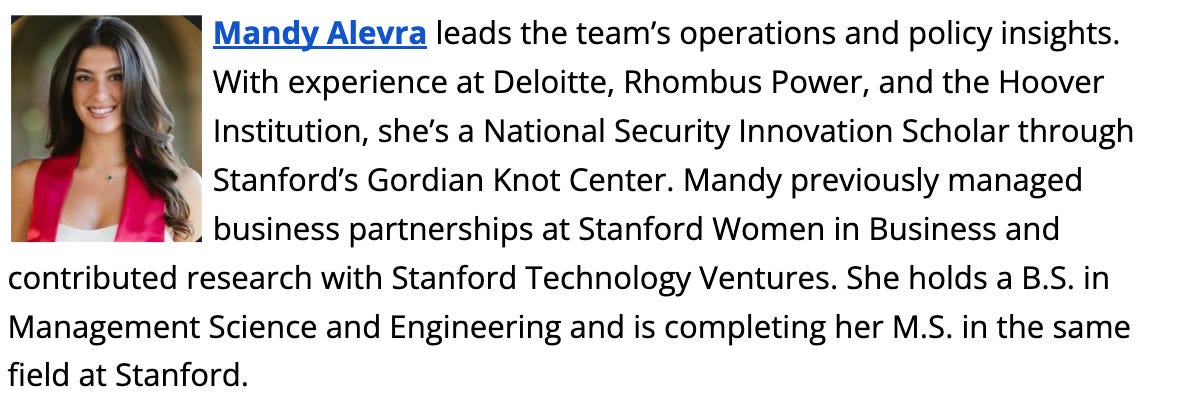You’ve stayed with us through all of our previous seven team blogs. Here’s our eighth and final for this spring term on Team Strom Inc.
As tensions mount between the United States and China, the pressure on global supply chains — especially for rare earth elements and critical minerals — has become a defining challenge of modern defense strategy. In July 2023, China restricted the export of gallium and germanium, two essential materials used in semiconductor manufacturing, radar systems and satellite communications. These minerals, along with others like antimony and graphite, are foundational to technologies that power everything from electric vehicles to hypersonic weapons.
Without them, the United States risks a dangerous bottleneck: stalled chip production, delayed weapons systems and national security vulnerabilities.
Team Strom Inc., one of Stanford University’s Spring 2025 Hacking for Defense (H4D) teams, is tackling this problem head-on. Focused on solving a problem submitted by In-Q-Tel, the team is developing strategies to reduce U.S. dependency on adversarial supply chains for critical minerals with the ultimate goal of restoring resilience to America’s defense industrial base.
Their mission: identify which minerals are truly irreplaceable, map global dependencies, and develop actionable pathways to mitigate the chokehold through innovation, alternative sourcing and policy interventions.
The Challenge: Critical Materials, Vulnerable Pipelines
Modern defense platforms — from F-35 fighter jets to next-generation radar arrays — rely on a shortlist of exotic materials. The problem is that most of them are mined, processed, or controlled by countries that may not share U.S. strategic interests.
China alone controls a dominant share of the global supply for many of the most critical minerals, including:
Gallium – used in high-speed chips and radar.
Germanium – used in infrared optics, fiber optics, and solar cells.
Antimony – used in armor-piercing rounds and flame retardants.
And these are just the tip of the iceberg. Team Strom Inc. is analyzing a broader basket of 20–30 essential minerals to determine:
Which ones are fundamental to military and commercial technologies?
Where supply is vulnerable or monopolized?
How demand will evolve with emerging technologies like quantum, AI, and hypersonic systems?
Their research is laying the groundwork for both technological and policy responses, whether that means investing in substitution, expanding domestic extraction, forging new international supply partnerships, or advancing materials science to eliminate dependencies altogether.
Meet Team Strom Inc.
The Stakes
Team Strom Inc.’s interviews with stakeholders in government, defense, semiconductor manufacturing, and mining have revealed a fragile ecosystem. They’ve identified three key paths forward:
Diversify supply chains. Invest in friendly nations and domestic producers to reduce concentration risk.
Innovate substitution. Accelerate research into alternative materials that can replace the most vulnerable elements.
Rethink procurement. Enable faster acquisition pathways and forward-looking investments in critical materials security.
This isn’t just about minerals — it’s about maintaining technological superiority, economic security, and strategic independence.
If successful, Strom Inc.’s work could guide federal investments, inform acquisition strategy and help ensure that America’s defense systems are never dependent on a single supplier or single point of failure.
See the Teams in Action
All eight (8) H4D teams will present their findings at Stanford University on Tuesday, June 3, at 5:15 pm PT. Join in person or online via livestream. RSVP HERE to secure your spot and learn more about their innovative work.
Here are the other H4D Team blogs to date:
Team Hydra Strike: Good-enough systems, produced quickly at scale, will determine the outcome of future maritime conflicts
Team OmniComm: Creating Autonomous Multi-Network SatCom
Team ArgusNet: Turning Satellite Chaos into Clear Paths for Crisis Response
Team Omnyra: Building a Safer Future for Synthetic Biology
Team ChipForce: Team Looks to Build Incentives to Prioritize U.S. Critical Minerals
Team Neolens: Rewiring Maintenance for Mission Readiness
Team HyperWatch: Building a high-altitude sensing platform to give regional missile defense an early edge against hypersonic threats
The Hacking for Defense (H4D) program has been taught at 70 colleges and universities around the world and has created 72 startups that have generated 660 jobs and raised more than $350 million. To learn more about the H4D course at Stanford University visit h4d.stanford.edu; to learn more about H4D around the world visit h4d.us. To learn more about The Hacking for Defense® Manual by Jeff Decker, PhD, visit Amazon.










